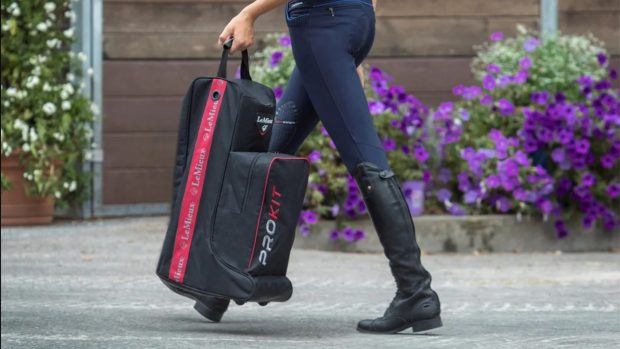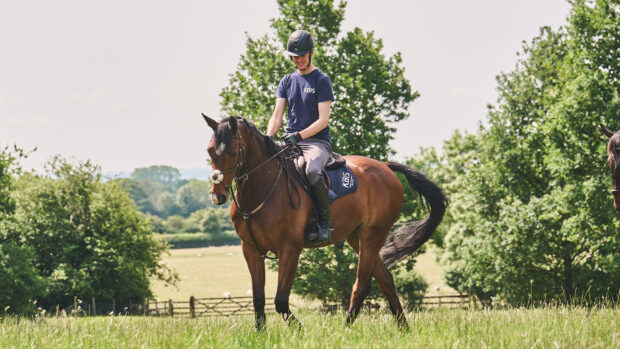Every rider will remember getting their first pair of long riding boots and the feeling of putting them on for the first time. The boots of top riders are so often admired and tradestands selling new designs are always busy at events.
It’s not uncommon for riders who fall from their horse to plead and protest when the emergency services suggest cutting off their precious boots, despite being in a great deal of pain – and not just because they took a long time to save up for. But have things always been this way?
Rachel Beckham heads up product development at Dublin and has been with the business at WeatherBeeta for more than 20 years. In this time she has witnessed a real shift in both consumer behaviour and product design.
“Looking back to the 1980s and early ’90s, equestrian footwear was very basic,” Rachel explains. “The majority of riders wore pull-on leather-soled jodhpur boots, while slush-moulded boots – the long rubber riding boots – were also very common. In addition to these, most riders had a pair of wellies for the yard and whenever you needed waterproof boots, although riding in wellies wasn’t uncommon either.”
The more serious riders would also have owned a pair of tall leather boots, but “these were kept for best and certainly not worn every day,” Rachel adds. “Options were limited and only a few styles were available. Boots were almost all exclusively bought off the peg – there was usually only one calf width and if your legs were narrower or wider than the standard you would have to make it work. Nowadays, custom made-to-measure boots are so much more common.”
A major innovation, which came in the early-mid 1990s, was the introduction of zips into both long boots and jodhpur boots.
“Zips made a big difference to those with higher insteps, who struggled to put boots on easily, but it also enabled a more custom fit from tall boots,” says Rachel. “Adding a zip and an elasticated panel immediately gives a boot a much snugger fit. Zips were quite an innovation of their time, but something we really take for granted these days.”
Affordability of tall boots
Ariat’s assistant product manager for footwear, Lissy Beesley, notes that they have seen sales of tall boots increase in particular over the years.
“Consumers are able to access higher-quality styles at more affordable prices,” she says. “Now that tall boots are commonly worn as everyday boots, some riders own multiple pairs, rather than keep them back for special events and competition.”
Brands are always looking for ways to improve the comfort and fit of their riding boots, and the area of boot design that has seen the biggest evolution is comfort.
“A lot of the improvements and technologies that improve comfort can be harder to see – unless you were to look at boots from this year and 1990 side by side – but there has been a lot of investment in this area,” Rachel reveals.
“All the top brands will have their own comfort system within the boot, and the sole will be made of multiple layers, including a steel shank for stability and support. Within the heel, there is usually some sort of rebound structure for cushioning and shock absorption, and common materials include TPU [thermoplastic polyurethane] and TPR [thermoplastic rubber] rather than leather, wood or cork. These materials make all the difference when you dismount in the cold and offer much greater traction and grip.”
Not only do riding boots provide improved comfort and fit, but some winter-focused designs offer warmth and waterproofness, which has made them more suitable for wearing out of the saddle, too.
“More emphasis has also been placed on breathability – as no one wants sweaty feet,” adds Rachel. “Some boots have Gore-Tex lining, while others have waterproof and breathable membranes – these fabrics and materials are really technical and you’d notice if they were taken away.”
Long riding boots tailored to your sport
While most dress and field boots available will serve you well for a wide range of disciplines, as you climb the levels you’re more likely to want something specific. Dressage boots tend to be stiffer and straighter as they emphasise a tall, elongated figure and keep your leg still while still allowing good feel. Meanwhile boots designed for showjumpers are usually made of a close contact, soft leather and have a more contoured fit.
Along with the functionality of the cut and design, the demand and supply of aesthetic options has exploded.
Kirstie Jones has worked at Joshua Jones, the UK distributor of Italian brands DeNiro and Donadeo, for more than six years.
“You’ll have noticed the days of choosing between black and brown are over,” she says. “You can now find boots in almost any colour, with a choice of trims, while crystals and croc prints are proving to be extremely popular. This allows riders to create a truly personalised boot to finish their competition outfit.
“Showjumpers are typically all about colour co-ordination and showjumping rules allow riders to design a dream boot,” Kirstie elaborates. “It’s possible to choose between many different colours of leather, patterned top sections, types of stitching and the option for additional crystals. You can also get matching spur straps to complete the look.
“On the other hand, dressage riders tend to favour a more elegant look. Dressage boots are also available in a huge choice of colours, with the brushed, highly buffed leather being very popular.”
Many event riders will wear the same boots for all three disciplines, but the higher up the levels you look the more likely riders are to have a selection of boots they prefer to wear in each phase.
Showing remains a traditional discipline.
“The rear zip has improved fit and look, while the traditional garter strap, which was designed to keep breeches in place, is now included purely for aesthetic purpose to uphold tradition. While all the new designs are beautiful, there is something wonderful about keeping old traditions alive,” Kirstie adds.
Boots for the rider as an athlete
Rachel believes one of the drivers for all these changes is equestrianism becoming more sport focused – these days if you’re an elite rider you’re an athlete. Boots, along with the rest of your kit, have become more of a performance-enhancing product, rather than just something you wear.
“Some newer boots are particularly lightweight, which will be of benefit on the cross-country course. Higher quality leathers can provide better grip and feel, while comfort systems make them more comfortable for wearing all day,” she adds. “It all contributes to enhancing your performance as a rider.”
When it comes to choosing a new pair of boots, there are a few different things you should consider. For Rachel, once you’ve made sure your boots comply with competition rules, it’s all about comfort.
“You could be wearing these boots for a very long time, both in the hours that you’ll wear them at a time and for the years they’ll last – you’ve got to be comfortable,” she insists. “There is no point wearing the same boots as your equestrian idol if they rub your feet raw.
“Bear in mind that leather is a natural product and it will give, too – the boots will stretch and become looser over time, so you want them to be on the tighter side to begin with. Then once you’ve got them, make sure you look after them,” Rachel advises. “It’s easy to forget that leather is skin – moisturise it like you would your own skin.”
Lissy says the right boot is one that works effectively for your end use. Consider your budget, fit, comfort, styling and level of competition.
“And most importantly, do they make you smile?”
You might also like:

16 of the best long leather riding boots for every budget

A pick of the best short boots for riders of all ages and abilities

The best half chaps and gaiters to pair with your favourite short boots

Subscribe to Horse & Hound magazine today – and enjoy unlimited website access all year round
Horse & Hound magazine, out every Thursday, is packed with all the latest news and reports, as well as interviews, specials, nostalgia, vet and training advice. Find how you can enjoy the magazine delivered to your door every week, plus options to upgrade your subscription to access our online service that brings you breaking news and reports as well as other benefits.





